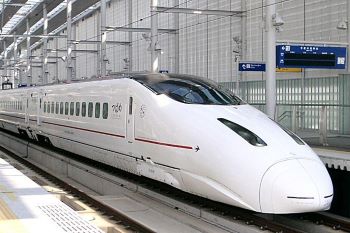Passenger train services • Main line services / Ticketing • High speed Rail • Japan • JR Kyushu
➤ See also: Shinkansen overview – Shinkansen infrastructure and stations – JR Hokkaïdo – JR East – JR Central – JR West
➤ See also: High speed train in France – High speed train in Germany – High speed train in Italy – Economics
Note: For educational purpose only. This page is meant purely as a documentation tool and has no legal effect. It is not a substitute for the official page of the operating company, manufacturer or official institutions. It cannot be used for staff training, which is the responsibility of approved institutions and companies.
👉 (Version française disponible)
In brief
In April 1987, the Japanese National Railways (JNR) were divided into seven companies: one for freight and six for passenger transport, known as JR. We will briefly present the high-speed rolling stock of each of these companies : JR Hokkaido, JR East, JR Central, JR West and JR Kyushu.
The JR Kyushu Shinkansen, a high-speed rail line operated by JR Kyushu, is a critical infrastructure component in southern Japan, linking Fukuoka (Hakata Station) and Kagoshima. The Kyushu Shinkansen began its first service on March 13, 2004, with the opening of the line’s initial segment between Shin-Yatsushiro and Kagoshima-Chuo. This was part of the southern section of the Kyushu Shinkansen Tsubame line.
Infrastructure managers: JR Kyushu
Operators: JR Kyushu
First services: 13 March 2004
Lenght of Shinkansen network : 256 km
Speed : 260km/h
Later, the entire line connecting Hakata (in Fukuoka) to Kagoshima-Chuo was completed and opened on March 12, 2011, enabling direct Shinkansen service across the entire Kyushu route. This marked the full integration of the Kyushu Shinkansen into Japan’s high-speed rail network.
The Kyushu Shinkansen employs the latest Shinkansen innovations, including lightweight aluminum trains, advanced earthquake detection, and automatic braking systems. Trains like the Series 800 are designed for both speed and energy efficiency, reaching up to 260 km/h. The integration of cutting-edge safety systems ensures reliable operations in a region prone to seismic activity. Overall, the JR Kyushu Shinkansen showcases Japan’s engineering excellence and its commitment to sustainable, high-speed transit.
Kagoshima and surrounding areas have seen increased economic activity as travel barriers were reduced. The project, costing over ¥1 trillion, was partly funded by the Japanese government, reflecting its strategic importance. The rail line has also catalyzed urban development around stations, encouraging investments in retail, real estate, and services.
The definition of a high-speed train varies by region, but generally, it refers to trains that operate at speeds of at least 250 km/h (155 mph) on newly built lines and 200 km/h (124 mph) on upgraded lines. In Europe, for example, the UIC (International Union of Railways) considers a commercial speed of 250 km/h as the principal criterion for high-speed rail. In the United States, the definition can include trains operating at speeds ranging from 180 km/h (110 mph) to 240 km/h (150 mph).
➤ See the UIC definition
National rolling stock (past and present)

Hitachi
2004 – …

6-cars version
Hitachi, Nippon Sharyo
2022 – …
[TOP]
Infrastructure • High speed Rail • Japan • Lexical
